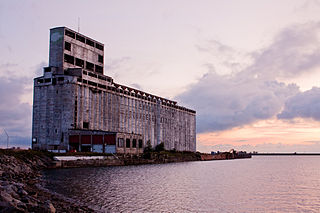
A grain elevator is a facility designed to stockpile or store grain. In the grain trade, the term "grain elevator" also describes a tower containing a bucket elevator or a pneumatic conveyor, which scoops up grain from a lower level and deposits it in a silo or other storage facility.
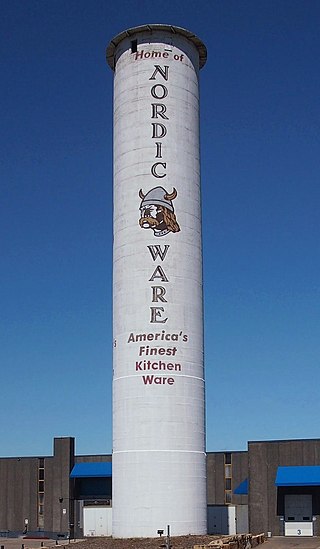
The Peavey–Haglin Experimental Concrete Grain Elevator is the world's first known cylindrical concrete grain elevator. It was built from 1899 to 1900 in St. Louis Park, Minnesota, United States, as an experiment to prove the design was viable. It was an improvement on wooden elevators that were continually at risk for catching fire or even exploding. Its cylindrical concrete design became the industry standard in the United States, revolutionizing grain storage practices. After its initial experiments, the Peavey–Haglin Elevator was never again used to store grain. Since the late 1960s it has been maintained on the grounds of the Nordic Ware company and is painted with their name and logo.

Falls Park is a public park in north central Sioux Falls, South Dakota, surrounding the city's waterfalls. The park includes a cafe, an observation tower, and the remains of an old mill.
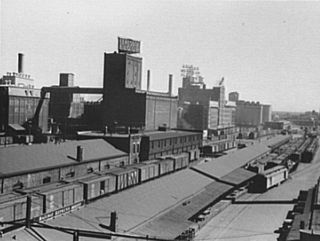
Northwestern Consolidated Milling Company was an American flour milling company that operated about one-quarter of the mills in Minneapolis, Minnesota, when the city was the flour milling capital of the world. Formed as a business entity, Northwestern produced flour for the half-century between 1891 and 1953, when its A Mill was converted to storage and light manufacturing. At its founding, Northwestern was the city's and the world's second-largest flour milling company after Pillsbury, with what is today General Mills a close third. The company became one of three constituents of a Minneapolis oligopoly that owned almost nine percent of the country's flour and grist production and products by 1905. This occurred as a result of their attempt at a United States monopoly.

Northwestern Consolidated Milling Company Elevator A also known as the Ceresota Elevator and "The Million Bushel Elevator" was a receiving and public grain elevator built by the Northwestern Consolidated Milling Company in 1908 in Minneapolis, Minnesota in the United States. The elevator may have been the largest brick elevator ever constructed and ran on electricity. The elevator was the source for the Crown Roller Mill and Standard Mill. Those mills closed in the 1950s but the elevator continued in use for grain storage until the mid 1980s. The building is a contributing property of the Saint Anthony Falls Historic District listed in the National Register of Historic Places in 1971.

The Saint Paul Municipal Grain Terminal is a six-story grain elevator also known as the head house and sack house, and sits on piers over the Mississippi River in Saint Paul, Minnesota, United States. It was built between 1927 and 1931 as part of the Equity Cooperative Exchange and is a remnant of Saint Paul's early history as a Mississippi River port city. The Saint Paul Municipal Grain Terminal was added to the National Register of Historic Places in 2004.

The Sheridan Flouring Mills, also known as the Mill Inn, are an industrial complex in Sheridan, Wyoming. The mills were a major component of the economy of north central Wyoming, providing collection, storage and milling of locally produced wheat and other grains into flour and other milled products. The original mill was established by Captain Scott W. Snively in the early 1890s. The Sheridan Milling and Manufacturing Company was sold to J.W. Denio in 1903, who operated the mill at its location on Broadway Avenue near downtown Sheridan. A catastrophic fire destroyed this mill in 1919, resulting in the purchase of a new location on Coffeen Avenue and construction of a much larger mill.

The Sioux Quartzite is a Proterozoic quartzite that is found in the region around the intersection of Minnesota, South Dakota, and Iowa, and correlates with other rock units throughout the upper midwestern and southwestern United States. It was formed by braided river deposits, and its correlative units are thought to possibly define a large sedimentary wedge that once covered the passive margin on the then-southern side of the North American craton. In human history, it provided the catlinite, or pipestone, that was used by the Plains Indians to carve ceremonial pipes. With the arrival of Europeans, it was heavily quarried for building stone, and was used in many prominent structures in Sioux Falls, South Dakota and shipped to construction sites around the Midwest. Sioux Quartzite has been and continues to be quarried in Jasper, Minnesota at the Jasper Stone Company and Quarry, which itself was posted to the National Register of Historic Places on January 5, 1978. Jasper, Minnesota contains many turn-of-the-century quartzite buildings, including the school, churches and several other public and private structures, mostly abandoned.

Concrete-Central Elevator is a historic grain elevator located on the Buffalo River at 175 Buffalo River Buffalo in Erie County, New York.

Mill City Museum is a Minnesota Historical Society museum in Minneapolis. It opened in 2003 built in the ruins of the Washburn "A" Mill next to Mill Ruins Park on the banks of the Mississippi River. The museum focuses on the founding and growth of Minneapolis, especially flour milling and the other industries that used hydropower from Saint Anthony Falls.

American Grain Complex, also known as "The American", Russell-Miller Milling Co. Elevator, and Peavey Co. Elevator, is a historic grain elevator and flour milling complex located in South Buffalo, Buffalo, Erie County, New York. The complex consists of three contributing buildings and two contributing structures. They are the Elevator Building, Flour Building (1906-1924), office building, Moveable Marine Tower, and railroad tracks. The Elevator Building consists of the mainhouse, workhouse, and fixed marine tower, all built in 1905–1906, and an annex constructed in 1931. The complex was last owned by ConAgra Foods, who closed the elevator and mill in June 2001.
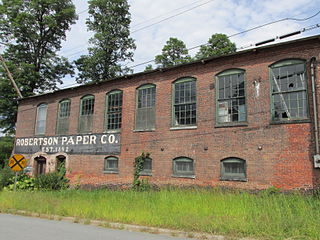
The Robertson Paper Company Complex was a historic industrial facility on Island Street in Bellows Falls, Vermont. It consisted of a collection of mostly-interconnected factory and related buildings, built between c. 1890 and c. 1960 by various paper-related companies. It was occupied and enlarged by the Robertson Paper Company between 1907 and its failure in 1987, at which time it was the longest-lived paper company in the state. The complex was listed on the National Register of Historic Places in 1990. It was demolished in 2018-19 as a Brownfields Economic Revitalization Alliance (BERA) project, with federal, state, and local funding.

The Mill at Freedom Falls is a historic mill complex at Mill and Pleasant Streets in Freedom, Maine. The main building, constructed in 1834, is the only mill built at this site, and the only one to survive nearly unaltered in the village. The mill and its surviving dam were listed on the National Register of Historic Places.
The Grenola Mill and Elevator is a grain elevator complex on Railroad Avenue in Grenola, Kansas. It was built in about 1909 and was listed on the National Register of Historic Places in 2002.

The Portage Industrial Waterfront Historic District is in Portage, Wisconsin.

The Oneida Milling and Elevator Company Grain Elevator, in Power County, Idaho near American Falls, Idaho, was built in 1912. It was listed on the National Register of Historic Places in 1993.

Min Hi Line is a proposed linear park and shared-use path that would eventually re-purpose an active rail and agri-industrial corridor in the Longfellow community of Minneapolis, Minnesota, United States. Modeled after successful projects like the Atlanta Beltline and New York High Line, it would feature an approximately 3-mile (4.8 km), shared-use pathway that traverses housing, retail, commercial buildings, gardens, playgrounds, and public art installments. Two pilot projects completed in 2018 and 2019 connect the Min Hi Line corridor to trail systems at its northern and southern ends.

The Orpheum Theater, formerly the Sioux Falls Community Playhouse, is a historic theater at 315 North Phillips Avenue in downtown Sioux Falls, South Dakota. It is the oldest theater in Sioux Falls and was listed on the National Register of Historic Places in 1983. Originally, it hosted vaudeville performances, and briefly served as a movie theater before being converted again into a stage theater, which it remains today.
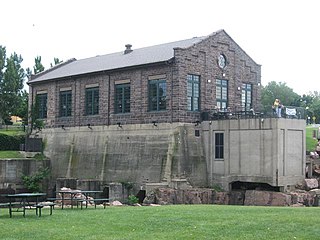
The Sioux Falls Light and Power Hydro Electric Plant, formerly the Northern States Power Building, is a historic building in Falls Park in Sioux Falls, South Dakota. Originally built as a hydroelectric power plant on the Big Sioux River, it now houses the Falls Overlook Cafe. It was listed on the National Register of Historic Places in 1993.






















